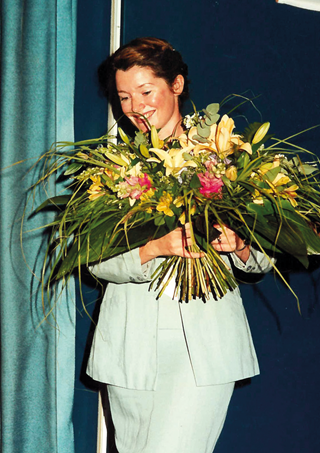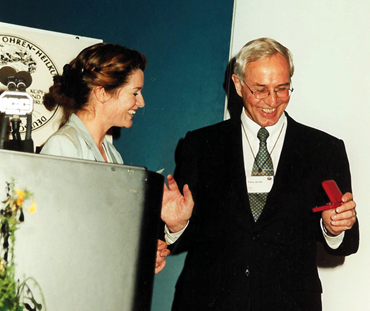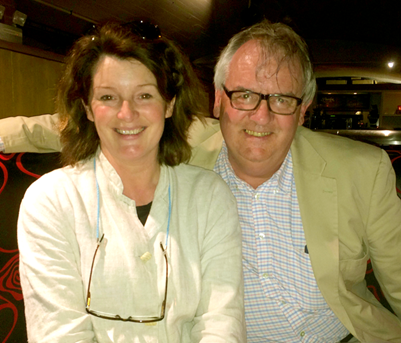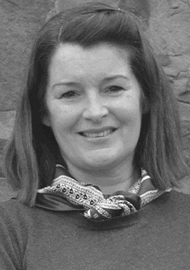Rosaleen Shine is synonymous with ENT and Audiology News. She was a key member of the team that founded what was then ENT News 25 years ago, and is well known to ORL and audiology colleagues all over the globe. Former editor, Ray Clarke, caught up with Rosaleen recently and put her on the spot regarding her thoughts and experiences on the magazine.

Tell me a bit about your background before ENT News. I think you told me you studied English and French and were a teacher for a period?
That’s right. Having spent four years teaching in Ireland, I took a career break with the intention of travelling. I joined Pinpoint Scotland in Edinburgh, just as the idea for ENT News was presented, and curiously, it was my ability to pronounce ‘otorhinolaryngology’ that was instrumental to my working on this project in the first place. By the time I could say ‘nasopharyngolaryngoscope’ and ‘hereditary haemorrhagic telangiectasia’, the project was on a roll!
How long did you think the mag would run?
The magazine almost didn’t happen! Initially in the autumn of ’91, there was not a lot of interest, as I phoned around the industry looking for advertising support for ENT News, as the proposed magazine was then known. Then one day a hard-backed envelope arrived with artwork for a quarter page advert for the Kamplex AD27 Audiometer and an accompanying comp slip indicating that PC Werth Ltd would take a series of adverts. Mr Cedric Chater, the publisher, encouraged me to “give another ring around” to the industry, and this time we got enough support to launch our first issue. Without support from the industry the magazine would never have been launched and we are proud of the fact that many of those who advertised in our first year still do so 25 years on. Sadly, as many UK readers will know, Mr Lawrence Werth, of PC Werth, passed away in August 2014. Over the years, Lawrence and I often joked about his quarter page advert being the catalyst that prompted us to go ahead with the magazine.
Had you any idea how popular ENT News would become?
In truth, no! Having said that, as a child I was a fan of the Readers Digest, so always grasped the appeal of the concise read. Very quickly it became our aim to have everything the busy specialist would need in one handy format. And of course the magazine has always been a team effort. It only exists because literally hundreds of ENTs and audiologists over the years have volunteered their services to edit, to review journals, websites and books, and to report on meetings or contribute articles. Because this editorial team were also readers, ideas and feedback were always flowing and innovations could be fed back into the magazine quickly and easily.
I remember that at one of the first BACO congresses I attended I saw how a group gathered around one of the keynote speakers, having photos taken with him as though he were a superstar, which of course he was! Immediately the idea to have interviews in the magazine was born. It has always been the aim to complement, not compete with journals, and we have aimed to deliver every type of news that might be of interest, whether it’s meeting reports, new products, latest books or website and tech reviews. Before the advent of social media and other channels of information, this format was hugely popular, and demand for the magazine grew quickly.
“It was my ability to pronounce ‘otorhinolaryngology’ that was instrumental to my working on this project in the first place. By the time I could say ‘nasopharyngolaryngoscope’ and ‘hereditary haemorrhagic telangiectasia’,
the project was on a roll!”
Again I would like to acknowledge the role of the industry in supporting the magazine and helping us to meet the demand for copies globally. If you look at page 13 you will see that, in 50 countries worldwide, the magazine is delivered free of charge to readers, thanks to sponsorship from local companies. We are grateful to the Dutch Company, Entermed, for being the first to sponsor free copies, to Dutch colleagues back in the ‘90s. Since then, many other companies have undertaken this distribution and in 2017 this will continue, thanks to Schoonenber, who will sponsor distribution of the magazine in The Netherlands for the ENT and audiology community. At one point 2,000 copies were being hand-delivered in India alone. In another case, an ENT doctor from one of the smaller Middle Eastern countries arranged for his brother, a pilot, to collect a box of magazines which he would then fly back in the cockpit for delivery to colleagues locally! We have always done our best to cater for demand.
Rosaleen receiving the ‘Golden Needle’ from Professor Klaus Jahnke in 2000.
You now work mainly from home. Do you miss the ‘buzz’ in the office?
I love visiting all the team in Edinburgh and meeting readers at the various meetings we attend. While working from home offers great flexibility, I do miss the buzz of being with the team, especially at deadline time. In fact, some of my fondest memories are of the early days of the magazine when we all worked late at deadlines and ordered pizzas to keep going and get the job done. I work with a fantastic team of people who pull together to make magic happen every time we hit a deadline.
You have worked with many authors, editors and interviewees, over the years – some with big reputations, some starting their careers – so you must have developed good antennae for what motivates us doctors at different times in our careers. Can you share any observations with us?
Trainees have always welcomed getting free access to journals, so it’s been a win-win formula for us that a journal reviewer can learn about the latest research while preparing reviews for publication. Over the years we have seen a lovely cycle of change and renewal. For example, the trainee becomes the busy consultant, the journal reviewer becomes the meeting organiser or the book author, and so, over time, our contributors have been able to step back from the magazine, and then engage again as the occasion demands. We have always been delighted that doctors were willing to report on meetings or conduct interviews for us and some of these interviews are really special.
I ask this as an editor myself. Any tips for those heart-sink times when you just can’t get an author to deliver to deadline? Or the text you get in is not what you wanted, and you are going to press next week?
Hey, you don’t really want me to answer that, do you? Let me answer a different question instead and that has to do with decision-making. It has always intrigued me how one will take a different decision depending on the time-frame. As Jimmy Smits of NYPD Blue said, “everything is a situation!” By this, I mean there are the decisions you make three weeks ahead of deadline – the ideal decisions – when you have time to play with and to fix things. And then there are the decisions you make when you are on deadline and you have to call it fast. Those quick decisions can be strangely liberating.
“Today there are some heroes, in both the ENT and audiology professions, who devote their time and resources to sharing information and promoting education locally and internationally. We salute them and are proud to support their work where we can.”
You have contributed hugely to the mag’s international focus. Is that important to you?
The success of the magazine is built on the connections forged by all of the Pinpoint team, both past and present. Currently Heather, Francesca, Linda, Nova, Mary and Polly each have strong personal links across both ENT and audiology, in the UK and further afield. These personal connections are crucial to the success of the magazine and reflect the various perspectives of the global readership. Our design and production team, led by Caroline and Donna, and ably supported by Charis, Stuart, Ross and Craig, also take a great interest in contributors and advertisers, and they too have forged their own personal connections over the years. We have readers in 140 countries worldwide and we take pride in having multi-national input on certain topics, or having a regional focus from time to time. I recall the late Professor Lichtenberger, from Hungary, telling me that during the period of the Iron Curtain, he signed up as medic to the international soccer team so that he could go on tour with them, visiting medical libraries in the various cities, while the team was training, and keeping himself up to date on the latest research. Today there are some heroes, in both the ENT and audiology professions, who devote their time and resources to sharing information and promoting education locally and internationally. We salute them and are proud to support their work where we can.
You once won the ‘Golden Needle’.Tell me a bit about it.
That’s right! I was honoured to receive the Ehrennadel der Gesellschaft or ‘Golden Needle’ from Prof Klaus Jahnke of the German ENT Society in May 2000 in Berlin. Our chief aim for the magazine has always been to create a forum for the communication of news and information and also to create links between the professions both nationally and internationally. With this in mind, I was delighted to work with Professor Jahnke, who was organising the 4th European Congress of Otorhinolaryngology, Head and Neck Surgery in Berlin, in May 2000. We explored lots of different channels to promote the event in a dynamic way, to maximum effect. The congress was wonderful and we were proud to play our part in its success. Afterwards I was surprised and delighted to be awarded this lovely ‘Needle’. I guess I felt a bit bashful too, being honoured, for ‘doing my job,’ which reminds me of the joke about the Kerry farmer who won the Nobel Prize for being ‘outstanding in his own field.’ I happened to be ‘standing in the field’ at that time, but it was a delight and an honour to accept this lovely award on behalf of all the team.
Rosaleen and Ray in 2016.
How you feel when the finished product – a shiny mag – hits your doormat?
When I worked at the Edinburgh office there were two moments of joy in the production cycle: first, when liaising with the editor in deciding on the editorial line-up for a particular issue – there is a particular creative buzz at that time, and again, as we put together our ‘dummy’ or in-house draft paper version. It’s always great fun seeing the magazine come together. But, curiously, by the time the magazine comes back from the printers, one opens it half in trepidation, through semi-closed eyes waiting for the typos to jump out.
What do people say the mag means to them when you meet them at conferences?
Readers usually say lovely things, but sometimes they can be quite funny. Years ago someone said, “Your magazine’s like The Beano – everybody reads it!” Several times I have had people say in a confidential tone that, “I actually read your magazine” – hinting perhaps they don’t always read their journals? Readers from Eastern Europe have said how much they valued being kept abreast of developments and how they would share an issue around their department. More recently, I met a senior manager with an audiology company who told me that he used to wait with anticipation for the magazine when he was an audiologist in India. It is always great to get reader feedback.
The mag has entered the social media era, with a twitter account and a Facebook page. How is that going and is it going to get bigger?
Yes, we have a great social media presence now and this is a fantastic platform to channel news and information quickly. Our next big development will be our new website, to be launched in the coming months. This digital platform will allow us to share information in new and dynamic ways and we have some very exciting ideas in store.
If you had to make a ‘mission statement’ for the mag, what would it be?
Forging links, sharing information and connecting people is the most important thing we do. We are a forum for the communication of news and information from every aspect of ENT and audiology, and we try to create links between these specialties both nationally and internationally. Over the years we have worked with some amazing members of the ENT and audiology professions, who give of their time freely in pursuit of these aims. It is both a pleasure and an honour to channel these contributions.
Interview conducted by Ray Clarke.







